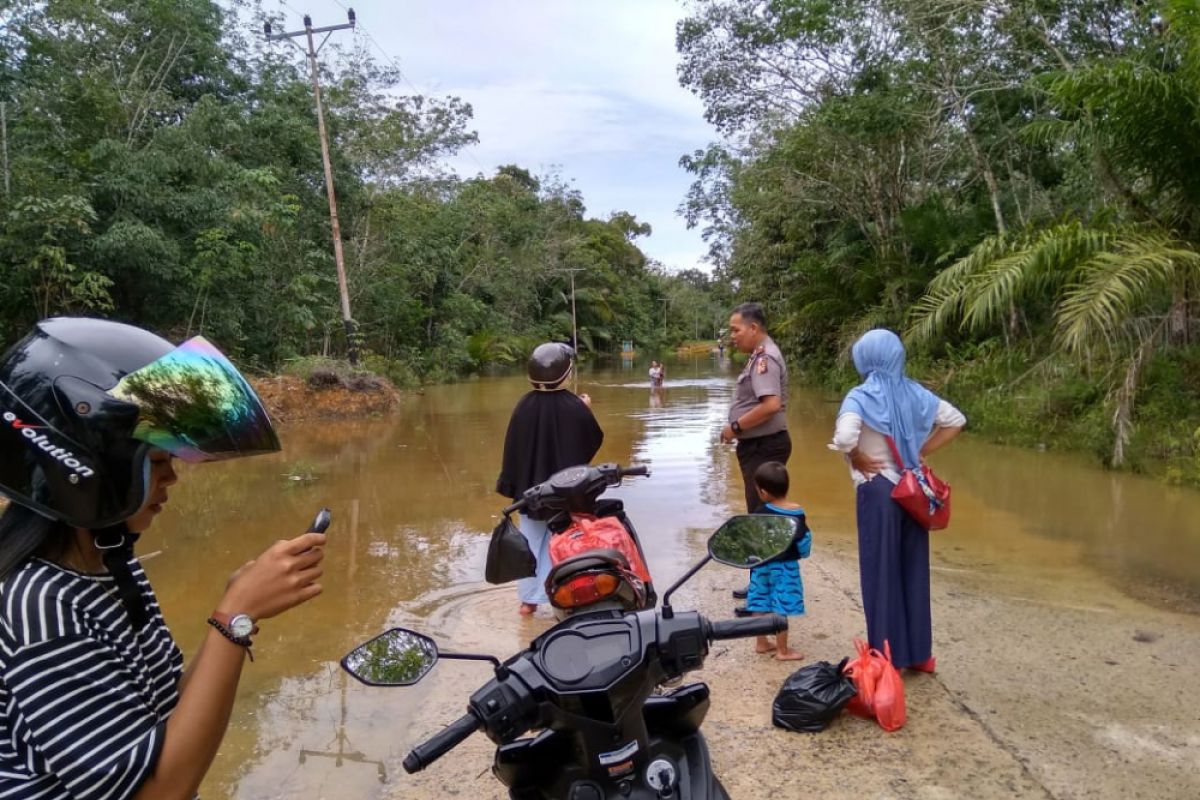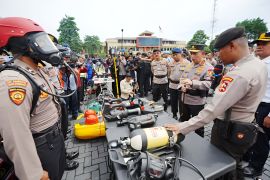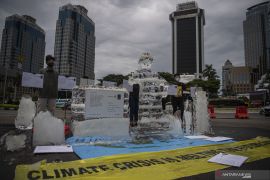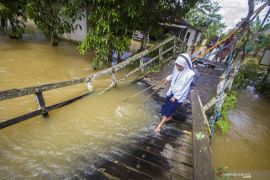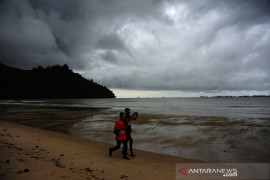The phenomenon, which has been developing since late last year and has triggered heavier than normal rainfall, is likely to continue until March.
According to the National Disaster Mitigation Agency (BNPB), a total of 372 natural disasters have struck Indonesia since January this year and left 216 persons dead and 12,056 others injured.
The natural disasters comprise 227 floods, 66 whirlwinds, 60 landslides, seven earthquakes, seven high tides or abrasions, and four forest fires, according to BNPB data, updated as of February 9, 2021.
The data also indicates 4,452 homes have incurred serious damage, 5,336 houses have suffered moderate damage, 37,569 houses have incurred light damage, and 357,365 houses have been flooded, leading to the displacement of 1,769,309 people to safer areas.
The natural disasters have also destroyed 1,290 public facilities and left at least seven people missing.
The major disasters that have occurred in January this year include landslides in Sumedang, West Java, on January 9; a 6.2-magnitude earthquake in West Sulawesi on January 15; and, massive flooding in South Kalimantan, starting January 12.
In early January, torrential rains and unstable soil triggered a series of landslides in Sumedang, which left 19 people dead, 11 others missing, 18 injured, and displaced over one thousand local residents. Rescuers were also among the deceased.
On January 15, 2021, an earthquake rocked the districts of Mamuju and Majene in West Sulawesi, claiming at least 105 lives and displacing thousands of people. The quake also destroyed several homes, infrastructure, and public facilities.
Indonesia, the world's largest archipelagic country located between Indian and Pacific Oceans, is prone to natural disasters as it is situated in the Pacific Ring of Fire, characterized by active volcanoes and frequent earthquakes.
Since October, 2020, head of the Meteorology, Climatology, and Geophysics Agency (BMKG), Dwikorita Karnawati, has issued early warnings of potential extreme weather-related conditions due to various phenomena that are feared to coincide with the rainy season.
Climate change and global warming have further exacerbated climate hazards and amplified the risk of extreme weather-related disasters, she pointed out.
The intensity of rainfall is rising year by year, while the La Nina and El Nino cycles are becoming shorter, according to Karnawati.
El Nino, which induces prolonged drought, and La Nina, which triggers very wet rainy seasons, are developing more frequently, she said. In 1981, the El Nino or La Nino cycles were repeating every 5-6 years, but by 2020, the cycles were repeating every 2-3 years, she added.
"This condition is influenced by climate change and global warming," Karnawati said during an online discussion on climate change on February 11, 2021.
Based on monitoring by BMKG, during 2015-2017, the average rainfall was recorded between 120 and 137 mm, but by January, 2020, the rain intensity had reached 337 mm.
The duration of rain in a day has also become longer due to the impact of climate change triggered by human activities, she observed.
Meanwhile, air pollution due to carbon dioxide (CO2) emissions from household appliances in 2004 was around 272 bpm, but by 2020, it increased to 400 bpm, she noted.
Based on a BMKG survey in 2015, the agency estimated that the ice at the top of Mount Jayawijaya, Papua, would run out by 2020 due to global warming. As a consequence, cyclonic winds could increase and potentially cause tornadoes.
To anticipate and mitigate the impact of natural phenomena, the BMKG is educating farmers and fishermen to adapt to weather and climate change to prevent harvest failure or fish catch decline.
The agency has also urged the Indonesian public to remain on alert for possible extreme weather during the February 10-16 period this year, when the rainy season will peak in several regions.
"Most areas are currently entering the peak of the rainy season, such as southern Sumatra, most parts of Java, including Jakarta, parts of Kalimantan, Bali, Nusa Tenggara, parts of Sulawesi, parts of Maluku, parts of West Papua, and parts of southern Papua,” BMKG deputy for meteorology, Guswanto, noted in a statement issued on February 10, 2021.
According to the BMKG’s analysis, unstable atmospheric dynamics in the next few days could increase the possibility of rain cloud growth in several Indonesian regions.
This is due to the emergence of low pressure centers around Australia and the emergence of cyclonic circulation around northern Indonesia that affects wind direction and speed patterns, thereby increasing the likelihood of rain cloud growth around Indonesia.
In early February, floods were reported in several parts of Indonesia, such as West Kalimantan, West Java, Aceh, Central Java, and Papua.
In West Java, at least 13,021 households reportedly bore the brunt of a landslide and flooding that inundated 92 areas in 27 villages and neighborhoods in Bekasi district.
The Bekasi Disaster Mitigation Agency (BPBD) reported on February 8, 2021 that heavy flooding inundated at least 12 sub-districts in the district following torrential rains over two days.
The floodwaters, reaching between 30 and 150 centimeters in height, swamped Cibitung, North Tambun, South Tambun, North Cikarang, Cabangbungin, Pebayuran, Sukawangi, Sukakarya, East Cikarang, Sukatani, Babelan, and Muara Gembong, the agency's acting head, Henri Lincoln, stated.
In addition to flooding, a whirlwind also hit Tamansari village, Setu sub-district, destroying 38 houses and minor damages to 35 others.
In Central Java, floods inundated 10 sub-districts in Semarang in the first week of February, following incessant and heavy rainfall in the city.
"The rainfall data shows that it is categorized as 'extreme'. Based on the hydrological analysis, the rainfall is a 50-year recurrence interval," Public Works and Housing Minister Basoeki Hadimoeljono said.
In West Kalimantan, unrelenting and torrential rains unleashed a flood fury that inundated 51 villages in 13 sub-districts in Sambas district on February 8, 2021.
Yusran, head of the Sambas District Disaster Mitigation Office (BPBD), on February 9, 2021 attributed the flooding to high-intensity rains and the flow of rainwater from upstream areas.
Sejangkung, Sajingan Besar, and Galing were among the flood-stricken sub-districts.
In the meantime, the Indonesian Forum for the Environment (Walhi) has urged the government to use the COVID-19-induced multi-dimensional crisis to make a change, particularly in the environmental sector, and treat it as a priority issue.
"The next few months are a crucial momentum for the Indonesian nation," Walhi executive director Nur Hidayati said during the virtual launch of Environmental Review 2021 recently.
The multi-dimensional crisis is related not only to health, social, and economic issues, but also environmental issues, including climate change, she remarked.
She pointed out that hydrometeorological disasters, such as extreme weather-induced flooding are a concrete impact of climate change caused by the increase in greenhouse gas emissions due to use of fossil fuels and reduction in forest cover.
Hence, the current moment is an important chance to improve and transform the existing system into an environmentally friendly one, she said.
Several countries have started taking steps in this direction, take for instance, the Green New Deal initiated by members of parliament in the United States, she added.
Coordinator of Walhi's political desk, Khalisa Khalid, also highlighted the significance of green politics and encouraged the endorsement of environmental issues as a priority.
Green politics may offer a solution to the polarization of environmental issues, encourage the adoption of more environmentally friendly policies, and support public interest since the environment has a direct and indirect impact on human life, she noted.
"We hope political awareness at the individual level, which refers to collective political awareness, will be able to turn environmental issues into the main agenda," she said.
So far, the environment has not been seen as a priority issue, she remarked. (INE)
Related news: Indonesia braces for La Nina-induced hydrometeorological disasters
Related news: BMKG projects above-normal rainfall in 27.5% of Indonesian territory
EDITED BY INE
Editor: Suharto
Copyright © ANTARA 2021
